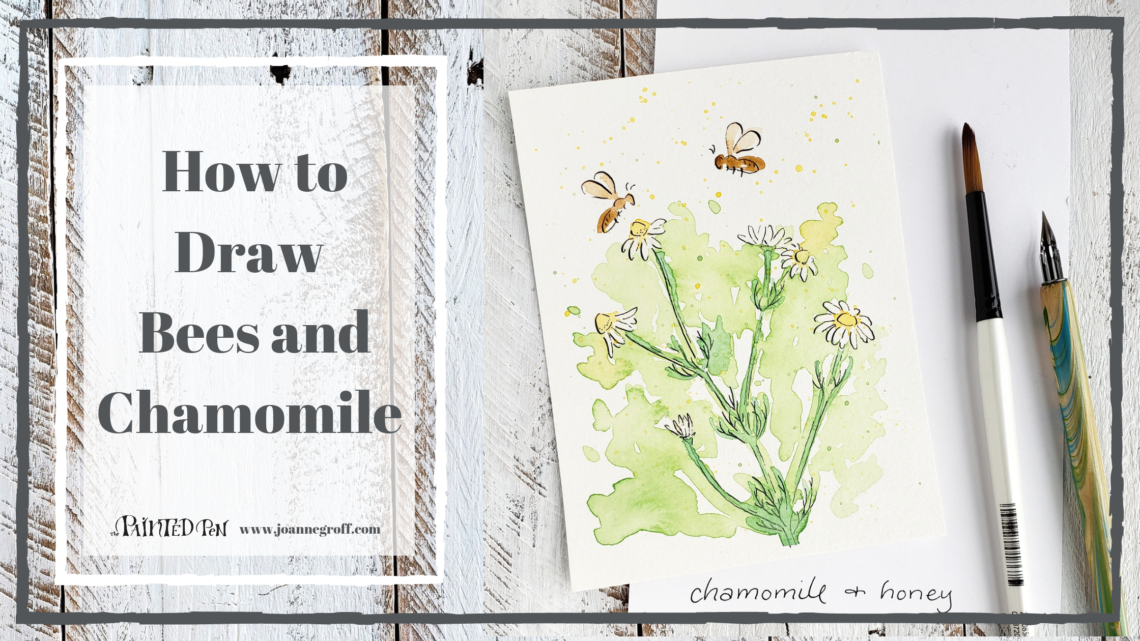
How to Draw Bees and Chamomile
Learn how to draw bees and give them something to collect with a few chamomile blooms.
It’s thawing outside. Tiny, almost imperceptible leaf buds are forming on the fruit trees (witnessed as I pruned the trees), and the bees are flying again. That means the hubby is planning for spring hive work, buzy bees and then honey season.
It’s still too early for actual blooming flowers, so we’ll have to imagine some …
Chamomile goes really well with honey.
Let’s draw our inspiration from these things for our tutorial.
Ready to paint a little spring?
Gather your supplies

- Basic calligraphy supplies with Ziller ink
- Basic Watercolor supplies
- Winsor & Newton Cotman Sketcher’s Pocket Box or your favorite blue
- Masking fluid
Read along for extra tricks and tips or jump to the video.
Chamomile and Honey Lettering
Let’s warm up with a little calligraphy. It’s always a good idea to get your hand used to some of the strokes you’ll use. Thick and thin, thick and thin. Write the words chamomile and honey with a calligraphy pen. Try it with a micron pen, too, if you want to.

Draw Bees and Chamomile
Now, take some time to think about how you want your drawing to look. Shall we draw bees flying over chamomile, ready to land and take a taste?
We’ll start with the li’l honeys. Here are some steps you can follow to draw a bee or two.
Always sketch with a pencil first. It will get your hand ready to make the shapes that you’ll be working with, and it won’t be so hard to work with proportions while you add ink (because they’ll already be there in pencil).
Below the bee drawing steps, you’ll see a few flower ideas for the chamomile. Draw the flowers facing several different directions as you would see it growing in real life.

Follow the steps to draw a bee. Find printable steps and more with How to Draw printable worksheets. 
Drawing with a calligraphy pen allows you to add thick and thin strokes throughout your drawing.
Try some Masking Fluid
Have you ever tried masking fluid? I have mixed feelings about it. If you use it all the time, it works wonders for leaving some areas white while you work with watercolors.
You just paint it on the paper, let it dry, and slop watercolors all over it. Peel it off when everything is dry, and voila! It saved the white area.

But … if like me, you use it only occasionally, it starts to dry out in the container. I managed to find some wet masking fluid under the rubberized glob on top.
Funny story: I tried to keep the masking fluid from rubberizing by storing it upside down. The lid was very hard to open … think rubbery goop stuck, but I managed to loosen it.
Used it. Closed it. Decided to use it again. When I opened it the second time … it blopped up and out, all over the container and my hands.
I wish I’d had a picture of that. There I stood wondering what to do while trying not to drip it all over the painting I was videoing … this tutorial. To make matters worse, I needed to leave right away to get my kids from school.
So, aside from the possibility of having a new way to exfoliate my skin, it’s a fun thing to play with but not to store.
We had a good laugh about it. You can too.
Watercolor Background Color
When the masking fluid is completely dry, you can paint around, even over it without worry. It will peel off with the fluid later.
With that in mind, paint a loose, green watercolor background around the stems and blooms.
Then, add some yellow to the centers of the flowers. Don’t worry about staying inside the lines. It all adds to the loose feel of the painting. Allow it to blend into the green background in a few areas too.
Finally, paint the bees brown. While the bodies will be a darker brown, paint the wings a lighter brown to give them a translucent look.

Paint the center of the chamomile yellow. 
Paint the bees brown.
Let it dry completely.
Gently rub the masking fluid with your finger (or you can use an eraser) to loosen it an pull it away from the chamomile petals. You can see how white it stayed on the finished picture at the bottom of the post.

Finishing Touches
A little splatter almost always looks nice to finish off a painting. Yellow and green will tie this together.
And you’re finished!
Feel free to try it again with a slightly different color, with no masking fluid (like the second one here) or in a different style completely. Have fun with it.

Watch How to Draw Bees and Chamomile
Enjoy the process.

Do you want printable worksheets to use as you draw and paint? Print steps, ideas, and a look at the finished piece with How to Draw printable worksheets for Draw Bees and Chamomile, found in the Products section.

